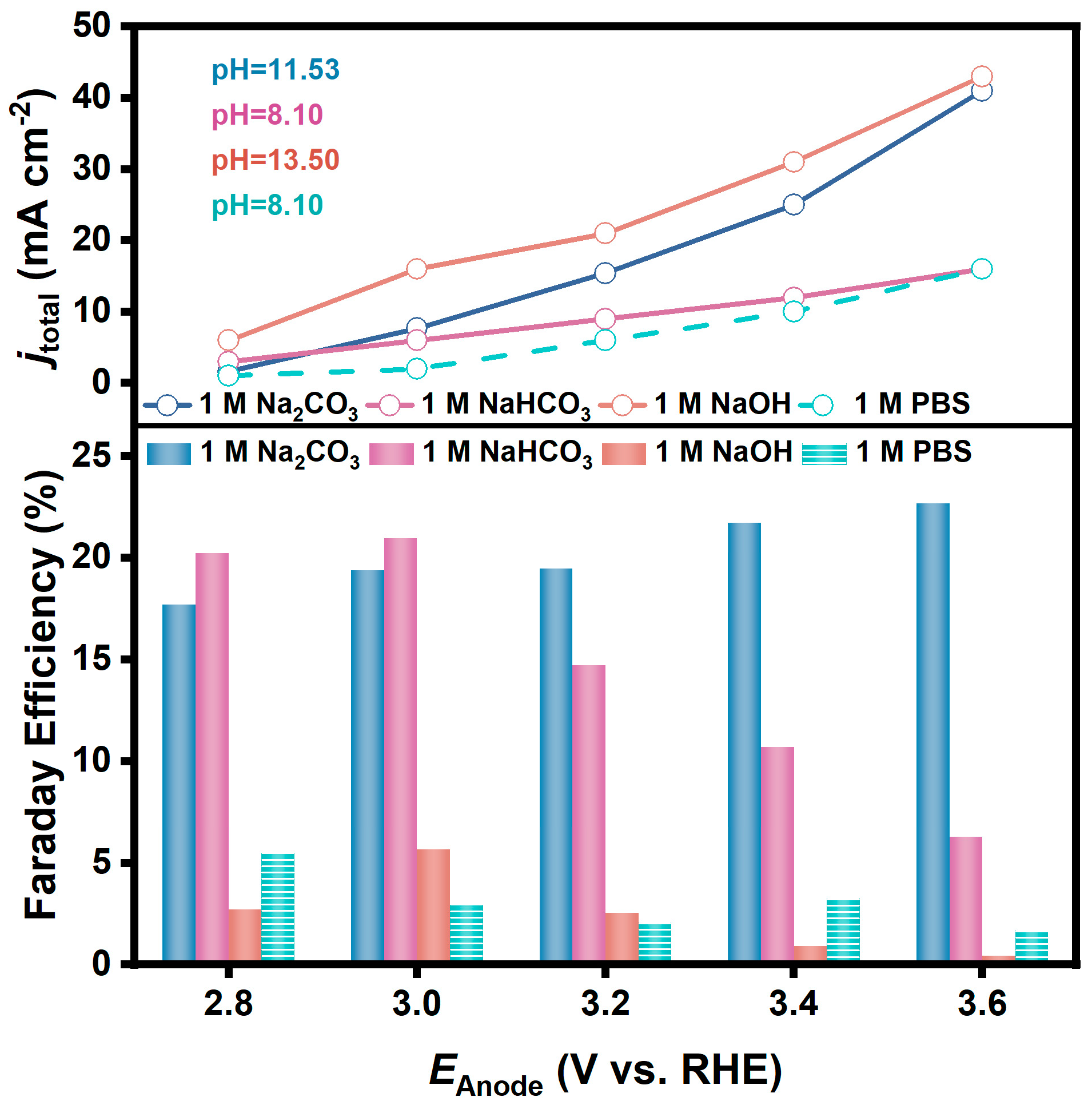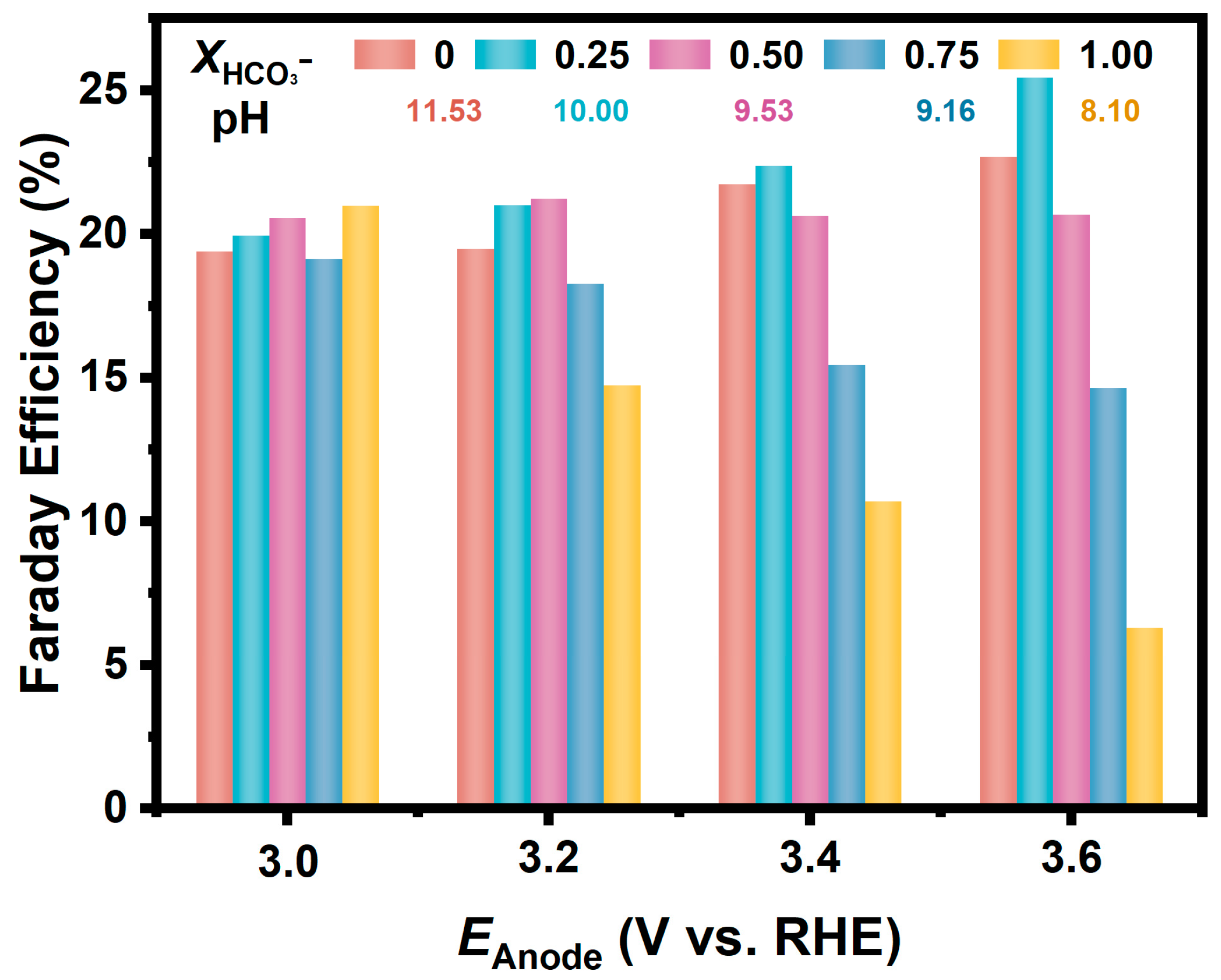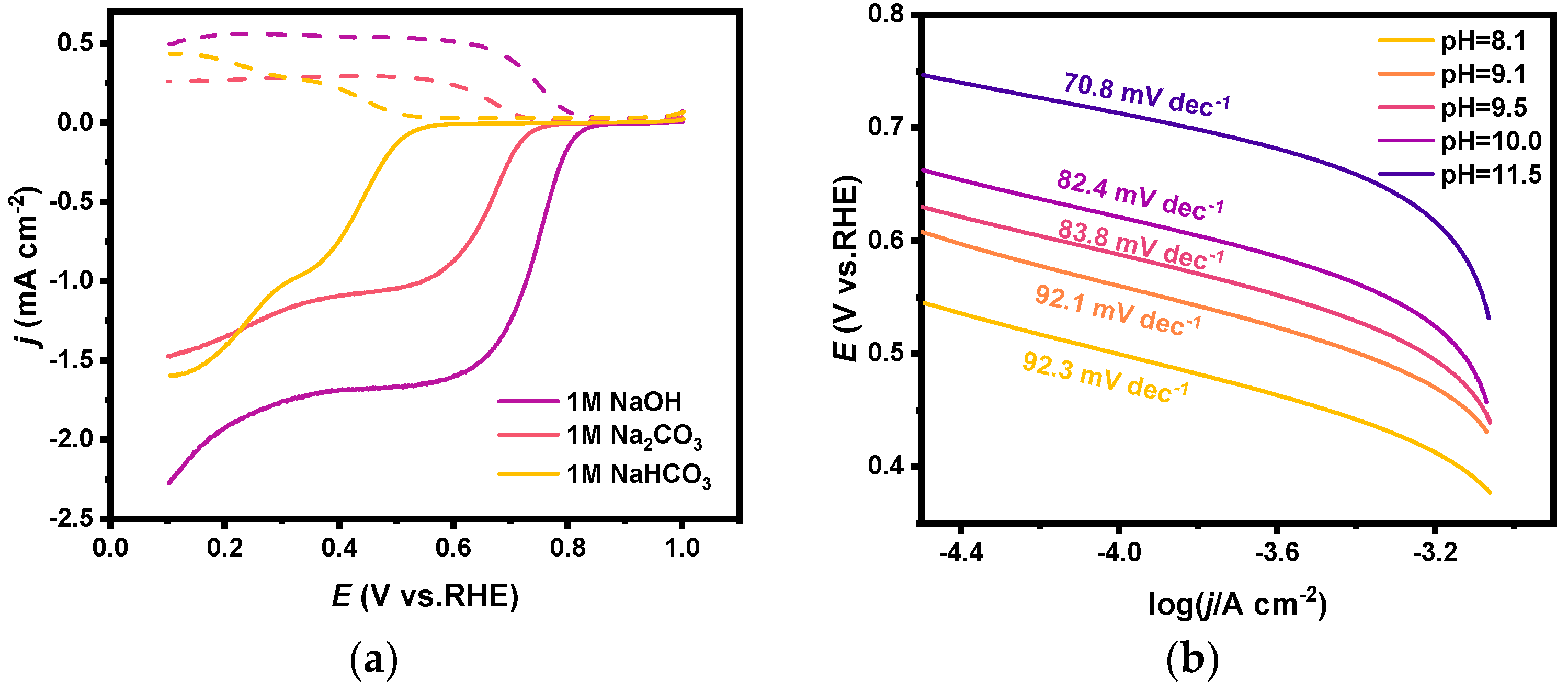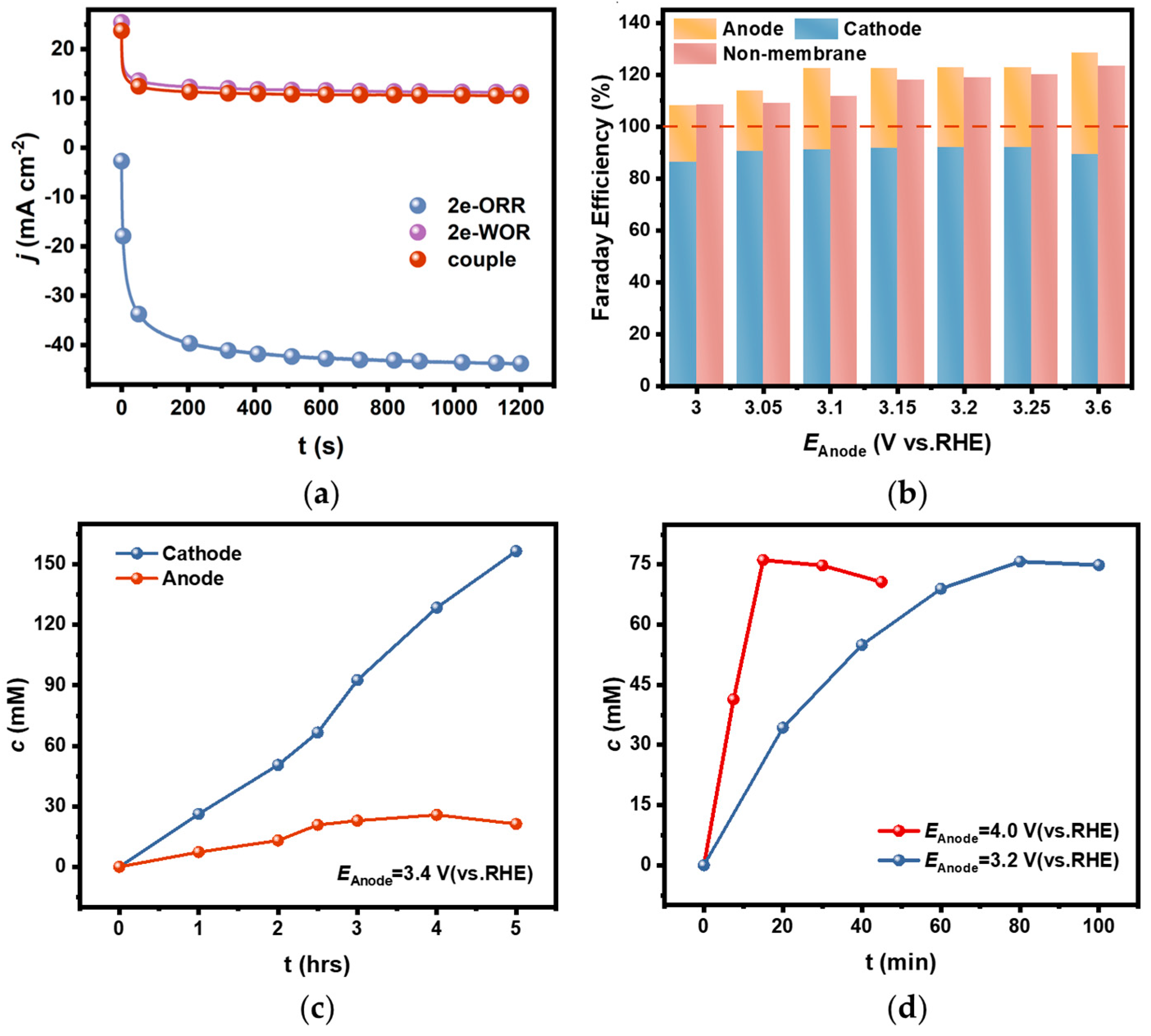Study on Influence Factors of H2O2 Generation Efficiency on Both Cathode and Anode in a Diaphragm-Free Bath
Abstract
1. Introduction
2. Materials and Methods
2.1. Preparation of Materials and Electrodes
2.2. Electrochemical Measurements and Electrolysis Systems
- Evaluation of catalytic performance for 2e-ORR
- 2.
- Evaluation of catalytic performance for 2e-WOR
- 3.
- Evaluation of the performance of H2O2 generation in coupled electrolytic systems
2.3. Determination of H2O2 in Electrolytes
2.4. The Analysed Steps of Oxidative Decomposition Rate Constant of H2O2 on Anodic Surface
3. Results and Discussion
3.1. FE for H2O2 Generation via 2e-WOR on FTO in Different Electrolytes
3.2. Factors Affecting the Accumulated Concentration of H2O2 in Carbonate Electrolytes
3.2.1. Self-Decomposition Rate of H2O2 in Different Solutions
3.2.2. Generation Rate of H2O2 via 2e-WOR on Anode
3.2.3. Oxidative Decomposition Rate of H2O2 on the Anodic Surface
3.3. Efficiency of H2O2 Generation via 2e-ORR in Carbonate Solutions
3.4. The Efficiency of H2O2 Generation in a Coupled Electrolytic System
4. Conclusions
- (1)
- The effect of the electrolyte on the H2O2 generation efficiency via 2e-WOR was investigated by using the FTO electrode as an anode in different electrolytes. The highest FE was observed in a mixed Na2CO3/NaHCO3 solution, and the reason is attributed to the oxidative decomposition of generated H2O2 on the anode being slow in this electrolyte.
- (2)
- The comparison of the coupled electrolytic system in a diaphragm bath and a diaphragm-free bath was performed. The results showed that the oxidative decomposition of generated H2O2 on the anode was the main reason for the decrease in accumulated concentration in the diaphragm-free electrolytic system.
- (3)
- A diaphragm-free coupled flow electrolysis system was developed to reduce anodic potential and prevent excessive accumulated concentration. This system successfully achieved the continuous generation of an 85 mM H2O2 concentration at a constant flow rate.
Supplementary Materials
Author Contributions
Funding
Institutional Review Board Statement
Informed Consent Statement
Data Availability Statement
Conflicts of Interest
References
- Yi, Y.; Wang, L.; Li, G.; Guo, H. A Review on Research Progress in the Direct Synthesis of Hydrogen Peroxide from Hydrogen and Oxygen: Noble-Metal Catalytic Method, Fuel-Cell Method and Plasma Method. Catal. Sci. Technol. 2016, 6, 1593–1610. [Google Scholar] [CrossRef]
- Pesterfield, L. The 100 Most Important Chemical Compounds: A Reference Guide (by Richard L. Myers). J. Chem. Educ. 2009, 86, 1182. [Google Scholar] [CrossRef]
- Chen, Z.; Chen, S.; Siahrostami, S.; Chakthranont, P.; Hahn, C.; Nordlund, D.; Dimosthenis, S.; Nørskov, J.K.; Bao, Z.; Jaramillo, T.F. Development of a Reactor with Carbon Catalysts for Modular-Scale, Low-Cost Electrochemical Generation of H2O2. React. Chem. Eng. 2017, 2, 239–245. [Google Scholar] [CrossRef]
- Zeng, Y.; Wu, G. Electrocatalytic H2O2 Generation for Disinfection. Chin. J. Catal. 2021, 42, 2149–2163. [Google Scholar] [CrossRef]
- Jiang, H.; Zhang, L.; Wang, Z.; Han, Z.; Ma, L.; Li, A.; Sun, Y.; Tang, Y.; Wan, P.; Zhang, R.; et al. Electrocatalytic Methane Direct Conversion to Methanol in Electrolyte of Ionic Liquid. Electrochim. Acta 2023, 445, 142065. [Google Scholar] [CrossRef]
- Xu, J.; Zheng, X.; Feng, Z.; Lu, Z.; Zhang, Z.; Huang, W.; Li, Y.; Vuckovic, D.; Li, Y.; Dai, S.; et al. Organic Wastewater Treatment by a Single-Atom Catalyst and Electrolytically Produced H2O2. Nat. Sustain. 2021, 4, 233–241. [Google Scholar] [CrossRef]
- Sterenchuk, T.P.; Belykh, L.B.; Skripov, N.I.; Sanzhieva, S.B.; Gvozdovskaya, K.L.; Schmidt, F.K. The Effect of Particle Size and the Modifier on the Properties of Palladium Catalysts in the Synthesis of Hydrogen Peroxide by the Anthraquinone Method. Kinet. Catal. 2018, 59, 585–592. [Google Scholar] [CrossRef]
- Campos-Martin, J.M.; Blanco-Brieva, G.; Fierro, J.L.G. Hydrogen Peroxide Synthesis: An Outlook beyond the Anthraquinone Process. Angew. Chem. Int. Ed. 2006, 45, 6962–6984. [Google Scholar] [CrossRef] [PubMed]
- Pangotra, D.; Csepei, L.-I.; Roth, A.; Sieber, V.; Vieira, L. Anodic Generation of Hydrogen Peroxide in Continuous Flow. Green Chem. 2022, 24, 7931–7940. [Google Scholar] [CrossRef]
- Perry, S.C.; Pangotra, D.; Vieira, L.; Csepei, L.-I.; Sieber, V.; Wang, L.; Ponce de León, C.; Walsh, F.C. Electrochemical Synthesis of Hydrogen Peroxide from Water and Oxygen. Nat. Rev. Chem. 2019, 3, 442–458. [Google Scholar] [CrossRef]
- Jiang, H.; Xue, A.; Wang, Z.; Xia, R.; Wang, L.; Tang, Y.; Wan, P.; Chen, Y. Electrochemical Degradation of Lignin by ROS. Sustain. Chem. 2020, 1, 345–360. [Google Scholar] [CrossRef]
- Jiang, H.; Cheng, Y.; Wang, Z.; Bai, Z.; Tang, Y.; Sun, Y.; Wan, P.; Chen, Y. Degradation of a Lignin Model Compound by ROS Generated In Situ through Controlled ORR in Ionic Liquid. J. Electrochem. Soc. 2021, 168, 016504. [Google Scholar] [CrossRef]
- Iglesias, D.; Giuliani, A.; Melchionna, M.; Marchesan, S.; Criado, A.; Nasi, L.; Bevilacqua, M.; Tavagnacco, C.; Vizza, F.; Prato, M.; et al. N-Doped Graphitized Carbon Nanohorns as a Forefront Electrocatalyst in Highly Selective O2 Reduction to H2O2. Chem 2018, 4, 106–123. [Google Scholar] [CrossRef]
- Zhao, X.; Liu, Y. Origin of Selective Production of Hydrogen Peroxide by Electrochemical Oxygen Reduction. J. Am. Chem. Soc. 2021, 143, 9423–9428. [Google Scholar] [CrossRef] [PubMed]
- Jiang, H.; Wang, L.; Qiao, L.; Xue, A.; Cheng, Y.; Chen, Y.; Ren, Y.; Chen, Y.; Wan, P. Improved Oxidative Cleavage of Lignin Model Compound by ORR in Protic Ionic Liquid. Int. J. Electrochem. Sci. 2019, 14, 2645–2654. [Google Scholar] [CrossRef]
- Zhao, X.; Levell, Z.H.; Yu, S.; Liu, Y. Atomistic Understanding of Two-Dimensional Electrocatalysts from First Principles. Chem. Rev. 2022, 122, 10675–10709. [Google Scholar] [CrossRef]
- Chen, S.; Luo, T.; Chen, K.; Lin, Y.; Fu, J.; Liu, K.; Cai, C.; Wang, Q.; Li, H.; Li, X.; et al. Chemical Identification of Catalytically Active Sites on Oxygen-Doped Carbon Nanosheet to Decipher the High Activity for Electro-Synthesis Hydrogen Peroxide. Angew. Chem. 2021, 133, 16743–16750. [Google Scholar] [CrossRef]
- Han, L.; Sun, Y.; Li, S.; Cheng, C.; Halbig, C.E.; Feicht, P.; Hübner, J.L.; Strasser, P.; Eigler, S. In-Plane Carbon Lattice-Defect Regulating Electrochemical Oxygen Reduction to Hydrogen Peroxide Production over Nitrogen-Doped Graphene. ACS Catal. 2019, 9, 1283–1288. [Google Scholar] [CrossRef]
- Zhao, K.; Su, Y.; Quan, X.; Liu, Y.; Chen, S.; Yu, H. Enhanced H2O2 Production by Selective Electrochemical Reduction of O2 on Fluorine-Doped Hierarchically Porous Carbon. J. Catal. 2018, 357, 118–126. [Google Scholar] [CrossRef]
- Jimenez-Villegas, S.; Kelly, S.R.; Siahrostami, S. SnO2 -Supported Single Metal Atoms: A Bifunctional Catalyst for the Electrochemical Synthesis of H2O2. J. Mater. Chem. A 2022, 10, 6115–6121. [Google Scholar] [CrossRef]
- Park, S.Y.; Abroshan, H.; Shi, X.; Jung, H.S.; Siahrostami, S.; Zheng, X. CaSnO3: An Electrocatalyst for Two-Electron Water Oxidation Reaction to Form H2O2. ACS Energy Lett. 2019, 4, 352–357. [Google Scholar] [CrossRef]
- Pangotra, D.; Csepei, L.-I.; Roth, A.; Ponce de León, C.; Sieber, V.; Vieira, L. Anodic Production of Hydrogen Peroxide Using Commercial Carbon Materials. Appl. Catal. B Environ. 2022, 303, 120848. [Google Scholar] [CrossRef]
- Zhang, X.; Xia, Y.; Xia, C.; Wang, H. Insights into Practical-Scale Electrochemical H2O2 Synthesis. Trends Chem. 2020, 2, 942–953. [Google Scholar] [CrossRef]
- Xue, Y.; Wang, Y.; Pan, Z.; Sayama, K. Electrochemical and Photoelectrochemical Water Oxidation for Hydrogen Peroxide Production. Angew. Chem. Int. Ed. 2021, 60, 10469–10480. [Google Scholar] [CrossRef] [PubMed]
- Mezzavilla, S.; Baldizzone, C.; Swertz, A.-C.; Hodnik, N.; Pizzutilo, E.; Polymeros, G.; Keeley, G.P.; Knossalla, J.; Heggen, M.; Mayrhofer, K.J.J.; et al. Structure–Activity–Stability Relationships for Space-Confined PtxNiy Nanoparticles in the Oxygen Reduction Reaction. ACS Catal. 2016, 6, 8058–8068. [Google Scholar] [CrossRef]
- Zhang, C.; Lu, R.; Liu, C.; Lu, J.; Zou, Y.; Yuan, L.; Wang, J.; Wang, G.; Zhao, Y.; Yu, C. Trimetallic Sulfide Hollow Superstructures with Engineered D-Band Center for Oxygen Reduction to Hydrogen Peroxide in Alkaline Solution. Adv. Sci. 2022, 9, 2104768. [Google Scholar] [CrossRef]
- Lu, Z.; Chen, G.; Siahrostami, S.; Chen, Z.; Liu, K.; Xie, J.; Liao, L.; Wu, T.; Lin, D.; Liu, Y.; et al. High-Efficiency Oxygen Reduction to Hydrogen Peroxide Catalysed by Oxidized Carbon Materials. Nat. Catal. 2018, 1, 156–162. [Google Scholar] [CrossRef]
- Pang, Y.; Wang, K.; Xie, H.; Sun, Y.; Titirici, M.-M.; Chai, G.-L. Mesoporous Carbon Hollow Spheres as Efficient Electrocatalysts for Oxygen Reduction to Hydrogen Peroxide in Neutral Electrolytes. ACS Catal. 2020, 10, 7434–7442. [Google Scholar] [CrossRef]
- Jiang, H.; Li, A.; Sun, Y.; Wang, L.; Chen, Y. Enhanced ORR Performance to Electrochemical Lignin Valorization in a Mixture of Ionic Liquid/Organic Solvent Binary Electrolytes. New J. Chem. 2023, 47, 18682–18689. [Google Scholar] [CrossRef]
- Shi, X.; Siahrostami, S.; Li, G.-L.; Zhang, Y.; Chakthranont, P.; Studt, F.; Jaramillo, T.F.; Zheng, X.; Nørskov, J.K. Understanding Activity Trends in Electrochemical Water Oxidation to Form Hydrogen Peroxide. Nat. Commun. 2017, 8, 701. [Google Scholar] [CrossRef] [PubMed]
- Mavrikis, S.; Göltz, M.; Perry, S.C.; Bogdan, F.; Leung, P.K.; Rosiwal, S.; Wang, L.; Ponce de León, C. Effective Hydrogen Peroxide Production from Electrochemical Water Oxidation. ACS Energy Lett. 2021, 6, 2369–2377. [Google Scholar] [CrossRef]
- Gill, T.M.; Vallez, L.; Zheng, X. Enhancing Electrochemical Water Oxidation toward H2O2 via Carbonaceous Electrolyte Engineering. ACS Appl. Energy Mater. 2021, 4, 12429–12435. [Google Scholar] [CrossRef]
- Dong, K.; Liang, J.; Wang, Y.; Ren, Y.; Xu, Z.; Zhou, H.; Li, L.; Liu, Q.; Luo, Y.; Li, T.; et al. Plasma-Induced Defective TiO2-X with Oxygen Vacancies: A High-Active and Robust Bifunctional Catalyst toward H2O2 Electrosynthesis. Chem. Catal. 2021, 1, 1437–1448. [Google Scholar] [CrossRef]
- Wang, Z.; Xu, W.; Tan, G.; Duan, X.; Yuan, B.; Sendeku, M.G.; Liu, H.; Li, T.; Wang, F.; Kuang, Y.; et al. Single Atomic Ru in TiO2 Boost Efficient Electrocatalytic Water Oxidation to Hydrogen Peroxide. Sci. Bull. 2023, 68, 613–621. [Google Scholar] [CrossRef] [PubMed]
- Xia, C.; Back, S.; Ringe, S.; Jiang, K.; Chen, F.; Sun, X.; Siahrostami, S.; Chan, K.; Wang, H. Confined Local Oxygen Gas Promotes Electrochemical Water Oxidation to Hydrogen Peroxide. Nat. Catal. 2020, 3, 125–134. [Google Scholar] [CrossRef]
- Kim, C.; Park, S.O.; Kwak, S.K.; Xia, Z.; Kim, G.; Dai, L. Concurrent Oxygen Reduction and Water Oxidation at High Ionic Strength for Scalable Electrosynthesis of Hydrogen Peroxide. Nat. Commun. 2023, 14, 5822. [Google Scholar] [CrossRef]
- Chang, Q.; Zhang, P.; Mostaghimi, A.H.B.; Zhao, X.; Denny, S.R.; Lee, J.H.; Gao, H.; Zhang, Y.; Xin, H.L.; Siahrostami, S.; et al. Promoting H2O2 Production via 2-Electron Oxygen Reduction by Coordinating Partially Oxidized Pd with Defect Carbon. Nat. Commun. 2020, 11, 2178. [Google Scholar] [CrossRef]
- Zhao, S.; Xi, H.; Zuo, Y.; Wang, Q.; Wang, Z.; Yan, Z. Bicarbonate-Activated Hydrogen Peroxide and Efficient Decontamination of Toxic Sulfur Mustard and Nerve Gas Simulants. J. Hazard. Mater. 2018, 344, 136–145. [Google Scholar] [CrossRef]
- Diyuk, V.E.; Vakaliuk, A.V.; Tsapyuk, G.G.; Yatsymyrskyi, A.V.; Mariychuk, R.; Boldyrieva, O.Y.; Lisnyak, V.V. Catalytic Decomposition of Hydrogen Peroxide on Nanoporous Activated Carbons: Effect of Surface Chemistry. Mol. Cryst. Liq. Cryst. 2023, 751, 137–148. [Google Scholar] [CrossRef]
- Rey, A.; Zazo, J.A.; Casas, J.A.; Bahamonde, A.; Rodriguez, J.J. Influence of the Structural and Surface Characteristics of Activated Carbon on the Catalytic Decomposition of Hydrogen Peroxide. Appl. Catal. A Gen. 2011, 402, 146–155. [Google Scholar] [CrossRef]
- Zeng, J.; Zhang, M.; Qin, X.; He, Y.; Liu, X.; Zhu, Y.; Liu, Z.; Li, W.; Dong, H.; Qiang, Z.; et al. Quenching Residual H2O2 from UV/H2O2 with Granular Activated Carbon: A Significant Impact of Bicarbonate. Chemosphere 2024, 354, 141670. [Google Scholar] [CrossRef] [PubMed]
- Ribeiro, R.S.; Silva, A.M.T.; Figueiredo, J.L.; Faria, J.L.; Gomes, H.T. The Influence of Structure and Surface Chemistry of Carbon Materials on the Decomposition of Hydrogen Peroxide. Carbon 2013, 62, 97–108. [Google Scholar] [CrossRef]
- Fan, L.; Bai, X.; Xia, C.; Zhang, X.; Zhao, X.; Xia, Y.; Wu, Z.-Y.; Lu, Y.; Liu, Y.; Wang, H. CO2/Carbonate-Mediated Electrochemical Water Oxidation to Hydrogen Peroxide. Nat. Commun. 2022, 13, 2668. [Google Scholar] [CrossRef] [PubMed]
- Gill, T.M.; Vallez, L.; Zheng, X. The Role of Bicarbonate-Based Electrolytes in H2O2 Production through Two-Electron Water Oxidation. ACS Energy Lett. 2021, 6, 2854–2862. [Google Scholar] [CrossRef]
- Bakhmutova-Albert, E.V.; Yao, H.; Denevan, D.E.; Richardson, D.E. Kinetics and Mechanism of Peroxymonocarbonate Formation. Inorg. Chem. 2010, 49, 11287–11296. [Google Scholar] [CrossRef] [PubMed]
- Vega, J.A.; Mustain, W.E. Effect of CO2, HCO3− and CO32− on Oxygen Reduction in Anion Exchange Membrane Fuel Cells. Electrochim. Acta 2010, 55, 1638–1644. [Google Scholar] [CrossRef]







Disclaimer/Publisher’s Note: The statements, opinions and data contained in all publications are solely those of the individual author(s) and contributor(s) and not of MDPI and/or the editor(s). MDPI and/or the editor(s) disclaim responsibility for any injury to people or property resulting from any ideas, methods, instructions or products referred to in the content. |
© 2024 by the authors. Licensee MDPI, Basel, Switzerland. This article is an open access article distributed under the terms and conditions of the Creative Commons Attribution (CC BY) license (https://creativecommons.org/licenses/by/4.0/).
Share and Cite
Tian, T.; Wang, Z.; Li, K.; Jin, H.; Tang, Y.; Sun, Y.; Wan, P.; Chen, Y. Study on Influence Factors of H2O2 Generation Efficiency on Both Cathode and Anode in a Diaphragm-Free Bath. Materials 2024, 17, 1748. https://doi.org/10.3390/ma17081748
Tian T, Wang Z, Li K, Jin H, Tang Y, Sun Y, Wan P, Chen Y. Study on Influence Factors of H2O2 Generation Efficiency on Both Cathode and Anode in a Diaphragm-Free Bath. Materials. 2024; 17(8):1748. https://doi.org/10.3390/ma17081748
Chicago/Turabian StyleTian, Tian, Zhaohui Wang, Kun Li, Honglei Jin, Yang Tang, Yanzhi Sun, Pingyu Wan, and Yongmei Chen. 2024. "Study on Influence Factors of H2O2 Generation Efficiency on Both Cathode and Anode in a Diaphragm-Free Bath" Materials 17, no. 8: 1748. https://doi.org/10.3390/ma17081748
APA StyleTian, T., Wang, Z., Li, K., Jin, H., Tang, Y., Sun, Y., Wan, P., & Chen, Y. (2024). Study on Influence Factors of H2O2 Generation Efficiency on Both Cathode and Anode in a Diaphragm-Free Bath. Materials, 17(8), 1748. https://doi.org/10.3390/ma17081748





